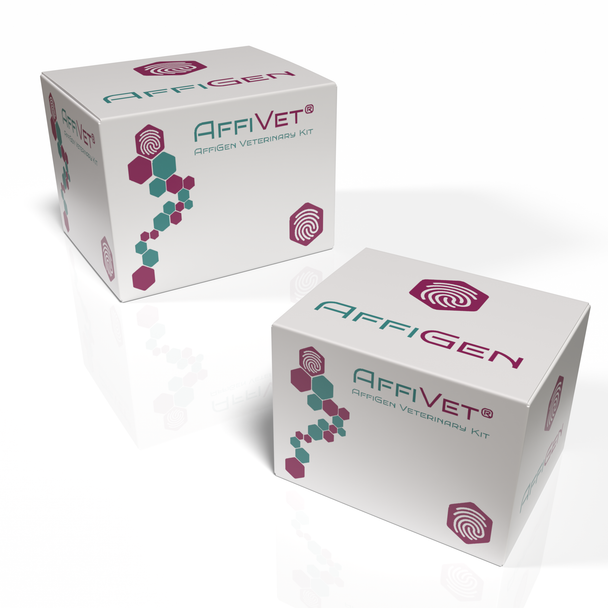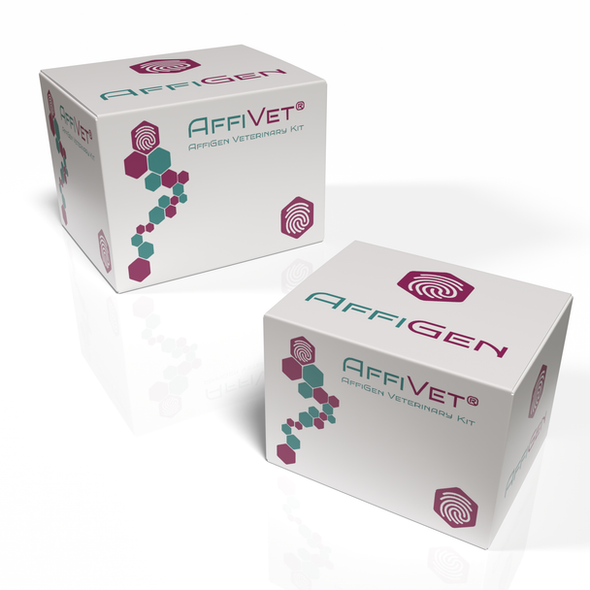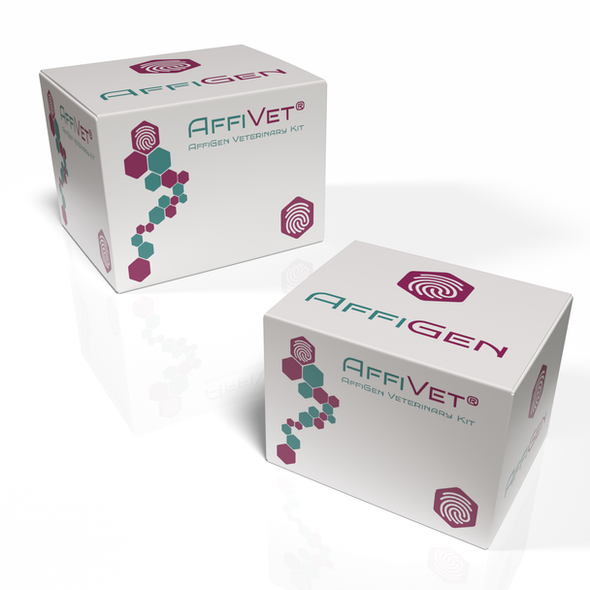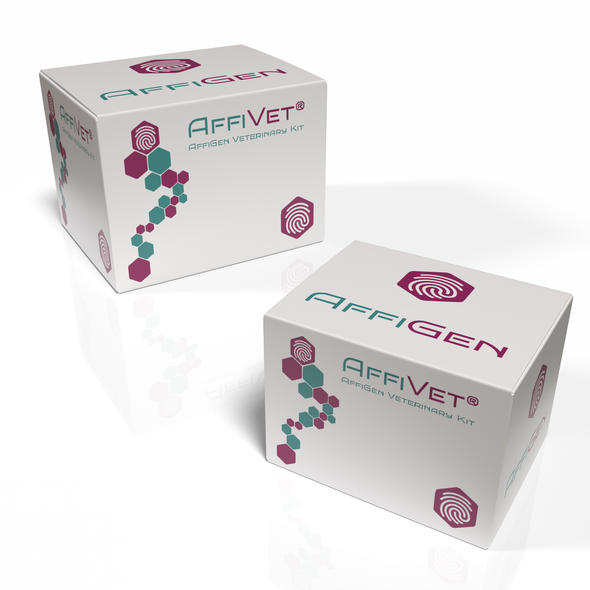AffiVET® Newcastle Disease Virus Antibody Elisa Kit
- SKU:
- AFG-VGS-40
- Method:
- Elisa
- Size:
- 96x2 Wells/kit
- Species:
- Poultry
- Specimen:
- Serum
Description
Newcastle Disease Virus Antibody Elisa Kit .
Newcastle disease virus (NDV) antibody ELISA kit
1. Introduction
The Green™ Newcastle disease virus (NDV) antibody ELISA kit is developed to detect theNDV antibodies level inchicken serum sample and can be used to evaluate serological diagnosis of infected chickens and Epidemiological surveys of Newcastle disease virus, analysis of Newcastle disease virus vaccine status in chickens.
2. Principle
This kitis based on solid-phase enzyme-linked immunosorbent assay (ELISA) principle,composedby the reaction Micro-plate coated with high purityNDV antigen, horseradish peroxidase-labeled anti-chicken IgG and other reagents. The reaction mechanismis thecoatedantigenbinding withNDV-Ab in sample, and then with the enzyme-labeled anti-chicken IgG antibody to form a "coatedantigen + NDV-Ab + anti-chicken IgG HRP antibody" complex, add substrate,it will have colorationby the enzyme catalytic reaction. Color depth is proportional to the amount of NDV-Ab, when the sample chromogenic reaction, the results detected by the microplate reader exceeds a set threshold value result judged as positive, indicating that the immune produced antibodies or natural infection exists.
3. The kit components
| 1 | NDV antigencoatedmicroplate | 96T X2 | |
| 2 | Enzyme conjugate | 22 ml | Yellow lid |
| 3 | Sample diluent | 50 ml | transparent lid |
| 4 | NDV-IgG Negative control serum | 1.5 ml | green lid |
| 5 | NDV-IgG Positive control serum | 1.5 ml | red lid |
| 6 | Substrate | 12 ml X 2 | orange lid |
| 7 | Stop solution | 12 ml | blue lid |
| 8 | 10×concentrated washing buffer | 50 ml | white lid |
| 9 | Adhesive Foil | 2 pieces | |
| 10 | Instruction | 1 piece | |
4. Materials Required But Not Provided
1 Microplate Reader (double-wave length: 450/630nm).
2 Micropipettes:single-channel1~100ml,0.5~10ml, multi-channel30~300ml
3 Microplate Washer.
4 Water bath or incubator.
5 Oscillator.
6 Disposable tips (10ul, 200ul)
7 Deionized water
5. Sample requirement
1. The test sample is chicken serum, collecting sample without bacteria, store at2℃~8℃for less than a week, store at lower than-20℃for long-term storage.
2. Avoid using sample ofsevere hemolysis, sediments, containing suspended long fibrin and pollution bacteria.
6. Preparation
1) BringELISA reagents to the room temperature (20-25℃) for 30 min to get best results.
2) Sample dilution: use the sample diluent to dilute the sample at 40 times(for example: 5ul serum sample+195ulSample diluent solution), mix the diluted sample evenly can get better result.
3) Washing solution preparation: Dilute the10×concentrated washing buffer with deionized water at10 times.(eg.10ml 10×concentrated washing buffer + 90mldeionized water ), if there is crystallization in the 10×concentrated washing buffer, it is normal, dissolve it at 37℃.
7. Test procedure
1. Adding sample: Take out the required coated plates according to sample quantity (Can be detached)and record the sample position on a worksheet. Set 2 wells for negative control serum and 2 wells for positive control serum, add undiluted negative and positive control serum to its well accordingly, 100μL/well. Others are sample wells, addthediluted sample,100 μl/well.
2. Incubation: cover withAdhesive Foil after adding sample,incubate at37℃for30 min.
3. Remove adhesive foil. Pour the liquid out of the wells, add Washing solution into each well fully, be static for about 10s, pour out directly. Repeat 3 times, at last time pat to dry on absorbent paper.
4. Add 100μL enzyme conjugate into each well.
5. Cover with adhesive foil andincubate at37℃for30 min.
6. Repeat step 3.
7. Add100μL substrate into each well, mix properly,Color for 10 min at37℃in the dark.
8. Add 50μL stop solution into each well, shake evenly for 10s, and determine the result.
9. Read OD value of each well with ELISA Reader at double-wave length: 450/630nm.
8. Results
Generally speaking, theaverageNDV-Positive control OD value should be≥ 0.6, theaverageNDV-Negative control OD value should be less than 0.1, otherwise the experiment do not success, re-test it.
The result is judged by S/P value,
S/P=(Sample OD450/630-NCx(—))/( PCx(—)- NCx(—)),NCx(—) means Negative control’s average OD450/630value,PCx(—) means Positive control’s average OD450/630value
If S/P≥0.20, it is positive; less than 0.20, it is negative.
9. Precautions and warnings for users
1. Read the Manual carefully before use.
2. Do not use reagents expired, do not mix reagents from different lots.
3.Experiment rubbish should bedealt with high pressure steam sterilization at121℃ for 30 minutes, or treated with 5.0g/L sodium hypochlorite disinfectant for 30 minutes, then discard.
4.MicroWell plate removed from the refrigerated environment should be balanced moisture to dry at room temperature, then can be opened. Put backunused MicroWell plateintodry foil bagandsealedat4℃.Unused liquid reagent should cover caps,store at 2-8℃ in dark with other group components.
5. Should useMicropipettor to add sample and reagents, and often proof its accuracy.
6. When adding washing buffer, should be full but no overflow, avoid appearing free enzyme at mouth of well or cross pollution between wells.
7. Stop solution is corrosive, use large amount of water to wash immediately when touch the skin or clothes.
Specification
Packing: 96 wells×2.
Expiry date:12 months.
Storage: Storing at 2~8 ℃in the dark, not freeze.
2 Reviews
-
Very nice
Reliable and user-friendly method for diagnosing exposure in poultry flock.
-
Eficacia
El kit de Elisa de anticuerpos contra el virus de la enfermedad de Newcastle de AffiVET® proporcionó resultados confiables con instrucciones claras, lo que facilitó su uso. Demostró una buena eficiencia y sensibilidad, lo que lo convierte en una herramienta valiosa para la investigación de la salud aviar. ¡Altamente recomendado!






